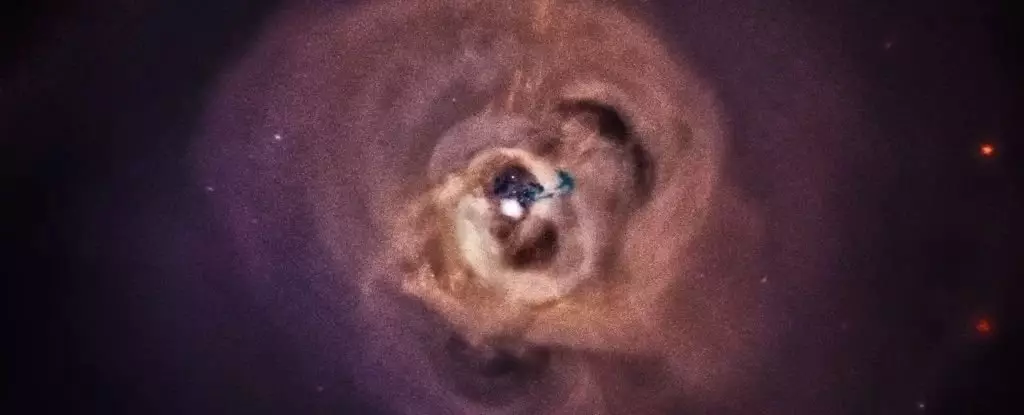In an astonishing exploration of sound waves emanating from the depths of the cosmos, NASA captured a captivating audio clip from a supermassive black hole located a staggering 250 million light-years away. Nestled within the heart of the Perseus cluster of galaxies, this black hole has been the focal point of scientific scrutiny since its acoustic waves were uncovered in 2003. For the first time, these ethereal sounds have been transposed and brought into the realm of human auditory perception, offering a unique glimpse into the otherwise invisible phenomena that dominate our universe.
Translating Cosmic Waves into Sound
The sonic translation performed by NASA has allowed listeners to experience frequencies that were previously unfathomable. By elevating the original sound waves by an impressive 57 to 58 octaves, scientists managed to create a haunting auditory experience that resonates with eeriness and intensity, reminiscent of a distant howling. Significantly, the lowest note detected—a B-flat over 57 octaves below middle C—presents a frequency imperceptible to the human ear at its natural state, unveiling an aspect of the universe that few have encountered.
It is essential to clarify a common misbelief regarding sound in space. While the notion prevails that space is a vacuum, effectively silencing all sound, the environment surrounding this particular black hole demonstrates that sound waves can indeed propagate in areas rich with gases. The Perseus cluster, unlike the majority of intergalactic space, is dense with plasma and hot gases, creating an atmosphere conducive for sound, intricately woven through the cosmos and compact enough to be detected by sophisticated technology.
The Role of Acoustic Waves in Galactic Evolution
Investigating the sonification of black holes not only opens the door to understanding sound waves but also provides insight into the complex dynamics of galaxy clusters. The intracluster medium, which is substantially denser and hotter than the intergalactic medium, plays an indispensable role in the architecture of galaxies. The energy transport through these sound waves actively contributes to the heating of the intracluster medium, influencing temperature regulation necessary for star formation and the broader evolutionary processes of galaxies.
In this light, researchers can begin to comprehend how acoustic waves might simultaneously act as a driving force in the evolution of these massive cosmic structures and contribute toward regulating their intricate balance. The exceedingly high-temperature environment further allows the detection of these sound waves, as the gases emit energetic X-rays that can be harnessed by the Chandra X-ray Observatory, revealing yet another dimension to the interplay between sound and x-ray emissions.
The sonification initiative does not stop with the Perseus black hole. Another notorious agility of NASA’s projects lies with M87*, the first black hole to receive direct imaging through the collaborative efforts of the Event Horizon Telescope. Exploring the elements surrounding this black hole unveiled striking jets of material ejected at remarkable velocities. Similar to the Perseus sonification, M87* was meticulously transformed into sound, albeit utilizing data from different forms of electromagnetic radiation.
By turning light into audible frequencies, researchers can experience cosmic occurrences uniquely. In these sonifications, radio data represents the lower frequency notes, while optical data occupies the mid-range, and high-energy X-rays culminate the audio spectrum. This method not only offers an enriching sensory experience but serves a pragmatic scientific purpose, allowing researchers to uncover potential anomalies and glean deeper insights into the enigmatic structures of our universe.
As we continue to develop advanced techniques in astrophysics and data visualization, the technique of sonification holds immense potential for future cosmic discoveries. The ability to translate vast datasets into an auditory form not only enhances public engagement with science, but it also provides researchers with innovative approaches to analyze and interpret astronomical phenomena. Through thoughtful sonification projects, scientists can break down complex data into understandable symphonies, revealing secrets of the universe that remain hidden in the silence of space.
NASA’s groundbreaking work with sound waves from supermassive black holes exemplifies the intersection of art and science, inviting us to listen to the celestial orchestra that plays far beyond our terrestrial home. As we untangle the symphony of our universe, the haunting melodies of black holes beckon us to ponder the profound mysteries that lie at the core of existence.

